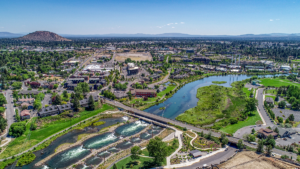
Bend, Oregon offers a unique blend of recreational attractions and outdoor adventures. The city features popular spots such as local breweries, an amphitheater, and even had the last remaining Blockbuster video-rental store in the world.
Outdoor enthusiasts can indulge in a wide range of sports, including mountain biking, fishing, hiking, camping, rock climbing, white-water rafting, skiing, paragliding, and golf. As the most populous city in Central Oregon, Bend claims a population of approximately 100,000 residents and around 1.4 million annual visitors, making it a bustling hub of activity.
Post-Covid Stats
In 2021, Bend, Oregon, experienced a total of 902 accidents, resulting in four fatalities. The data from these incidents reveal important insights:
- 43.46% involved injuries, ranging from serious cases requiring hospitalization and therapy to minor treatments in emergency rooms.
- 56.10% resulted in property damage, reflecting the economic impact that vehicle loss can have on families or businesses.
- 9.76% of accidents were collisions with fixed objects.
- 6.87% involved parked motor vehicles.
In 2021, 644 accidents occurred on city streets in Bend, compared to 258 on highways, once again highlighting the anomaly where urban areas pose greater danger than high-speed, multi-lane highways. Whether it’s a quiet neighborhood or a bustling downtown, these areas can often be more hazardous than major roadways. Among the incidents, 311 accidents were due to failure to yield, resulting in three deaths, while 265 were caused by following too closely or failing to avoid a collision.
Notably, emergency vehicles, log trucks, semi trailers, tractors, cabs, school buses, and transit buses were all involved in accidents. This stands out, as many cities go years without recording incidents involving these types of vehicles, yet in Bend, all were involved in crashes in a single year.
Pedestrian Risk
In Bend, the risk to pedestrians and cyclists is particularly alarming. 100% of the accidents involving cyclists resulted in either fatalities or severe injuries. Additionally, pedestrian fatalities mostly occurred when individuals were crossing straight paths, with half of these deaths happening at signed intersections, highlighting the dangers even in areas where traffic control measures are in place.
Road Conditions
The typical challenges of poor road conditions, such as wet surfaces or low visibility, do not have the same impact as in other cities. Surprisingly, the majority of accidents occur under favorable conditions. In 2021, a substantial 692 accidents happened during daylight hours, and despite the clear visibility, 75% of the fatalities occurred during the day. Furthermore, 736 accidents took place on dry roads, indicating that even in optimal conditions, accidents and fatalities are a significant issue.
While the data indicates that weather conditions typically have minimal impact on accident rates, this was starkly highlighted by a tragic event in January 2024. During a period of freezing rain, five individuals lost their lives in a single accident on Highway 97 as icy roads contributed to the severity of the incident.
Hotspots for Accidents in Bend
According to the OTSDE, these are the most dangerous areas for transit in Bend, Oregon:
The Dalles-California Highway, particularly where it intersects with Highway 97 and Powers Road, is a focal point for accidents of all severities.
NE Ninth St sees a significant number of incidents.
NW Newport Ave, near the roundabout, is another high-risk zone.
The area where Highway 97 becomes SE Third Street, close to the intersection with SE Division St, has a high frequency of accidents.
Fargo Ln, despite being a small street, has recorded two fatalities.
The intersection of SE 27th St and Bear Creek Rd is a known accident zone.
NE Greenwood Ave consistently reports accidents, with approximately 10 per block, especially at crossings like NE Eighth St, which sees high accident rates despite lower overall severity.
Concern for Greenwood Avenue
Greenwood Avenue, as it stands today, features a four-lane layout with two lanes of traffic in each direction, which has raised significant safety concerns for pedestrians. According to Marc Schlossberg, a professor of community and regional planning at the University of Oregon, this design is among the most hazardous for those attempting to cross on foot. Many locals echo these sentiments; for instance, a resident named Heylin expressed genuine fear about navigating this street, describing it as “terrifying.” He has had unsettling experiences both as a pedestrian and a cyclist, recounting that each time he has biked along Greenwood Avenue, he felt a sense of dread due to the traffic conditions.
Safety Projects
To enhance road safety and reduce accidents, the city is implementing several strategic measures. These initiatives focus on improving conditions for both pedestrians and cyclists, aiming to create a safer transportation environment for all users.
Here are some measures being taken:
- Painted Curb Extensions and Protected Crosswalks:
- Includes median islands, reducing pedestrian-related crashes by 31%.
- Buffered Bike Lanes:
- These lanes decrease bicycle-related accidents by 47%.
- Reduction of Travel Lanes for Vehicles:
- Transitioning to one lane in each direction with a dedicated left-turn lane, resulting in a 29% reduction in overall crashes.
Although these measures are a step in the right direction, it’s also important that drivers exercise caution, refrain from distracted driving, and maintain a safe following distance at all times. Only through continued diligence and consistent identification–and improvement of–problematic infrastructure, will we see a decline in motor vehicle accidents throughout Bend.
